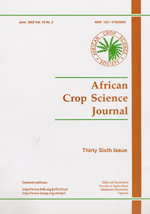
|
African Crop Science Journal
African Crop Science Society
ISSN: 1021-9730
EISSN: 1021-9730
Vol. 20, No. 1, 2012, pp. 67-75
|
 Bioline Code: cs12007
Bioline Code: cs12007
Full paper language: English
Document type: Research Article
Document available free of charge
|
|
|
African Crop Science Journal, Vol. 20, No. 1, 2012, pp. 67-75
| fr |
Takrama, J.; Dadzie, A.M.; Opoku, S.Y.; Padi, F.K.; Adomako, B.; Adu-Ampomah, Y.; Livingstone, D.S. III; Motamayor, J.C.; Schnell, R.J. & Kuhn, D.N.
Résumé
Au cours de cette recherche, 45 plants de cacao parentaux et 5 descendants dérivant du stock parental ont été génotypé en utilisant 6 marqueurs SNP, afin de déterminer les clones mal étiquetés et d’authentifier les croisements effectués dans le programme d’amélioration de l’Institut de Recherche sur le Cacao au Ghana (CRIG). Cette étude a été basée sur les 5' nucléases SNP en utilisant des bandes PCR "Hot Start mix Ready-To-Go PCR strips" et un Lecteur Microplat à Fluorescence "BioTek FLx800TBP". Au sein d’un groupe de six plants de cacao étiqueté PA150 et d’un autre groupe de cinq étiqueté Pound 7, il a été déterminé sans ambiguïté qu’un clone par groupe était mal étiqueté. De façon similaire, quatre génotypes différents ont été identifiés dans une même cohorte de clones 23PA7. En vérifiant la fidélité de cinq descendants issus du stock parental étudié, il a été établi qu’aucune erreur n’avait été faite lors du croisement. Le résultat le plus significatif de cette étude a été que, sur quatre catégories de 23 candidats PA7 de souches parentales, une seule pouvait être comparable au clone de référence dans la collection Internationale du Germoplasme de Cacao, Trinidad (ICG,T), démontrant ainsi la nécessité de travaux supplémentaires pour déterminer le clone exact parmi ceux évoqués précédemment. Il a ainsi été conclu que cette méthode avant-gardiste de génotypage, pourtantsimple, peut être utilisée dans les programmes appliqués d’amélioration du cacao dans un pays producteur. Ce travail représente une première étape dans la caractérisation génétique de la collection du germoplasme CRIG et jardins semenciers.
Mots Clés
Clones, lecteur à microplat fluorescent, genotyping
|
| |
| en |
Applying SNP marker technology in the cacao breeding programme in Ghana
Takrama, J.; Dadzie, A.M.; Opoku, S.Y.; Padi, F.K.; Adomako, B.; Adu-Ampomah, Y.; Livingstone, D.S. III; Motamayor, J.C.; Schnell, R.J. & Kuhn, D.N.
Abstract
In this investigation 45 parental cacao plants and five progeny derived from the parental stock studied were genotyped using six SNP markers to determine off-types or mislabeled clones and to authenticate crosses made in the Cocoa Research Institute of Ghana (CRIG) breeding programme. Investigation was based on the 5’ nuclease SNPassay using Illustra Hot Start mix Ready-To-Go PCR strips and BioTek FLx800TBP Fluorescence Microplate Reader. In a group of six cacao plants labeled as PA150 clones and another five labeled as Pound7, one clone in each group was unambiguously determined as off-type or mislabeled. Similarly, in a cohort of 23 PA7 "clones", four genotypes were differentiated. Cross-checking the fidelity of five progeny from the parental stock under study, it was established that no errors were made in the crossing. The most significant outcome of this study, however, was that out of the four categories of 23 PA7 candidate parental trees only one category can be comparable to the reference clone in the International Cacao Germplasm collection, Trinidad (ICG,T); thus informing the need for further work to find the correct clone among these for the breeding programme. It was thus concluded that thissimple yet cutting-edge genotyping procedure can be used in applied cocoa breeding programmes in a cocoa producing country. This work represents a first step in the genotypic characterisation of the CRIG germplasm collection and Seed Gardens.
Keywords
Clones, fluorescence microplate reader, genotyping
|
| |
© Copyright 2012 - African Crop Science Society
|
|
